
Hundreds of people lined the stone benches of the amphitheater in Denver’s Civic Center Park on the night of Aug. 28. They cheered for an end to systemic racism and mass incarceration even as rain-heavy skies loomed overhead.
“You don’t have to be out here in this weather. Give a hand clap for yourself,” a speaker told the crowd. They were there to mark the 57th anniversary of Martin Luther King Jr.’s March on Washington, with a rally that sounded just like any number of protests for justice since the killing of George Floyd in May.
But as evening set in, so did a change in the crowd.
A line of men wearing patchwork armor assembled at the edge of the rally. They had plywood shields, motorcycle helmets, bats and plate-armor vests. They were there, they said, to defend the protest — from police and from the counter demonstrators who would arrive later.
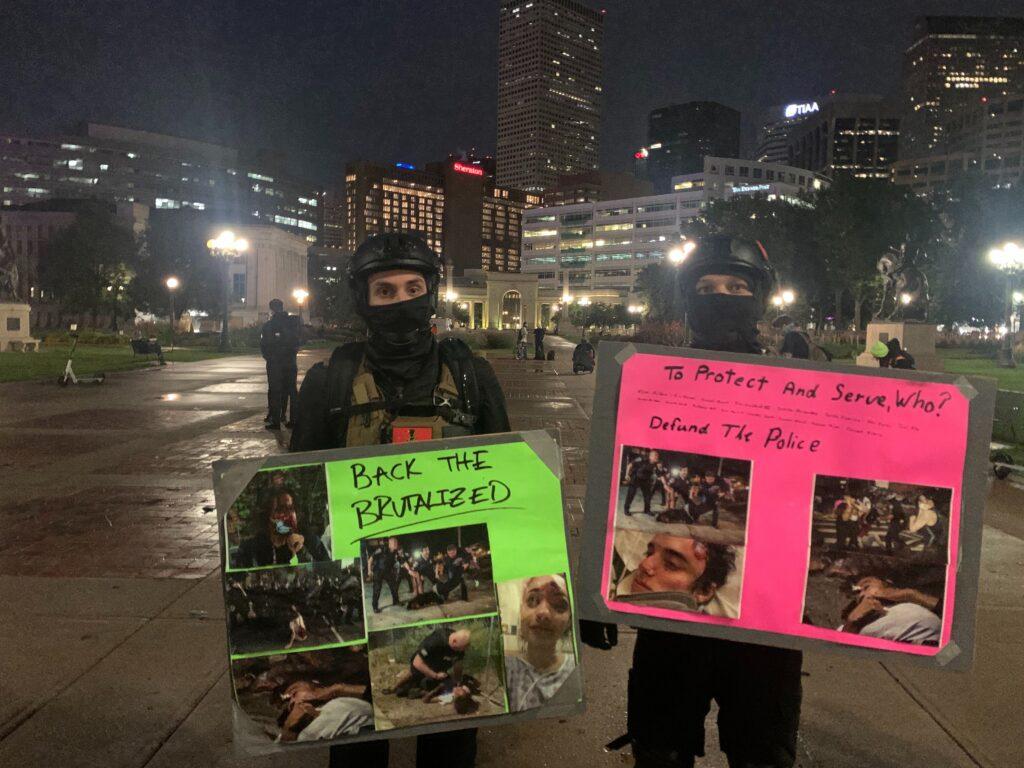
“I’m here to protect my fellow comrades. I’m here to protect anybody who wants to use their free speech to say Black Lives Matter,” said a 30-year-old man who refused to give his name out of fear that he might be targeted.
“You know, after everything that happened in Kenosha, people have to be ready to be shot at," he continued.
It had been just three days since 17-year-old Kyle Ritenhouse allegedly killed two men and shot a third at a protest in Kenosha, Wisconsin. His attorneys say Rittenhouse was acting in self-defense; Rittenhouse said he was guarding businesses amid apparent arson and looting. He faces murder charges.
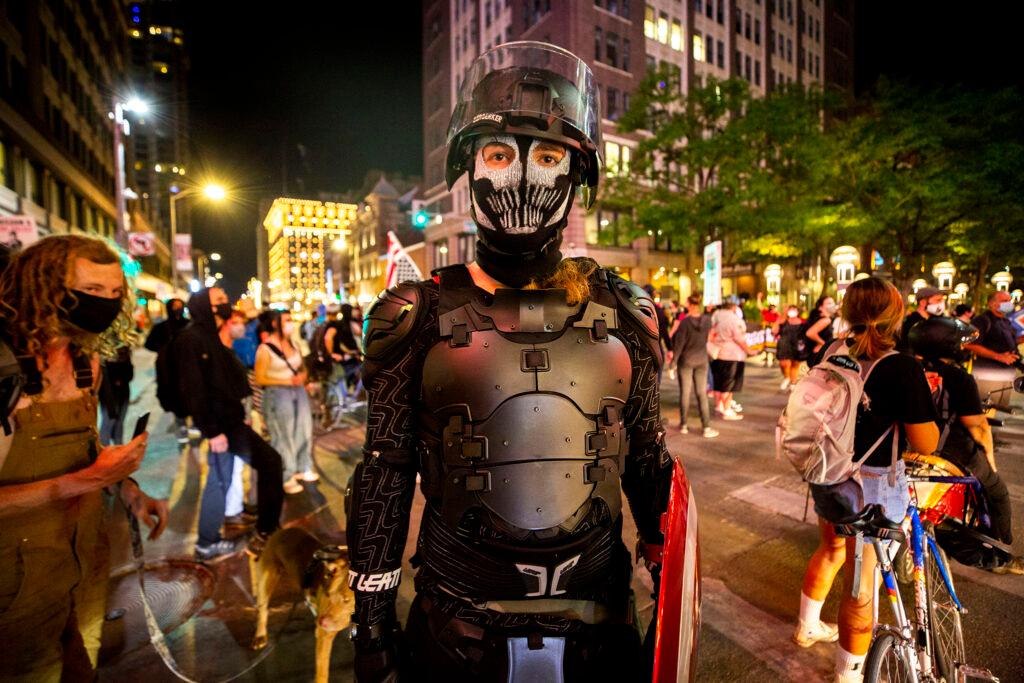
A change on the streets
The crowds at Denver’s evening protests are far smaller now than they were in May and June; it’s rare to see more than 100 people marching at night. But it’s more common to see armored and armed people in the mix -- and for those groups to run into counter-protesters who oppose them.
“I started my career in 1989. I’m in my 31st year. I have not seen anything like this before,” said Division Chief Ron Thomas of the Denver Police Department.
“We have to deal with a group of agitators and deal with this group of counter-protesters who potentially could be trying to exact violence against this group, and we don’t want that to happen.”
Unlike some other cities, Denver’s face-offs haven’t devolved into violence between organized groups, but this confrontational dynamic intensified in the closing weeks of summer. Images of a handful of small, destructive protests have captured the attention of news media, city officials and would-be vigilantes.
On Aug. 22, dozens of black-clad protesters faced off with cops at Denver police headquarters. It was billed as an effort to “give ‘em hell” in return for city leaders rejecting calls to abolish the police department. That night, people lit a tree on fire and broke the window of a nearby Quiznos.
A dozen people were arrested. One man faces a felony charge for allegedly throwing a firework that burned and may have concussed an officer. Another was arrested with 19 ninja stars in his bag, and a woman was accused of throwing a bike part at an officer. Others are accused of distributing “obstructive equipment” like shields, helmets and bats.
This was one of about a half-dozen times that demonstrators have tried to “breach” the fence at police facilities in recent weeks, according to Thomas. In a separate incident on September 1, eight people were arrested for allegedly trespassing at the police academy after someone cut a hole in the fence.
“I think it’s probably fair to say that it’s in the dozens (of people),” Thomas said of the demonstrators who are causing property damage. “It certainly is not the majority of the individuals who are out peacefully demonstrating.’
Mayor Michael Hancock has promised swift action against “anarchy” and “destruction.” These tactics are also a subject of debate within the protest movement itself. Some see it as a fringe distraction from the larger justice message. Tay Anderson, a Denver school-board director and occasional protest leader, has spoken out against property damage.
Some protesters will neither criticize nor condone damaging protests, saying they’re an expression of rage that remind the public of the need for change. And at the Civic Center rally on August 28, several armored protesters said that they aimed only to protect others, not to cause violence themselves.
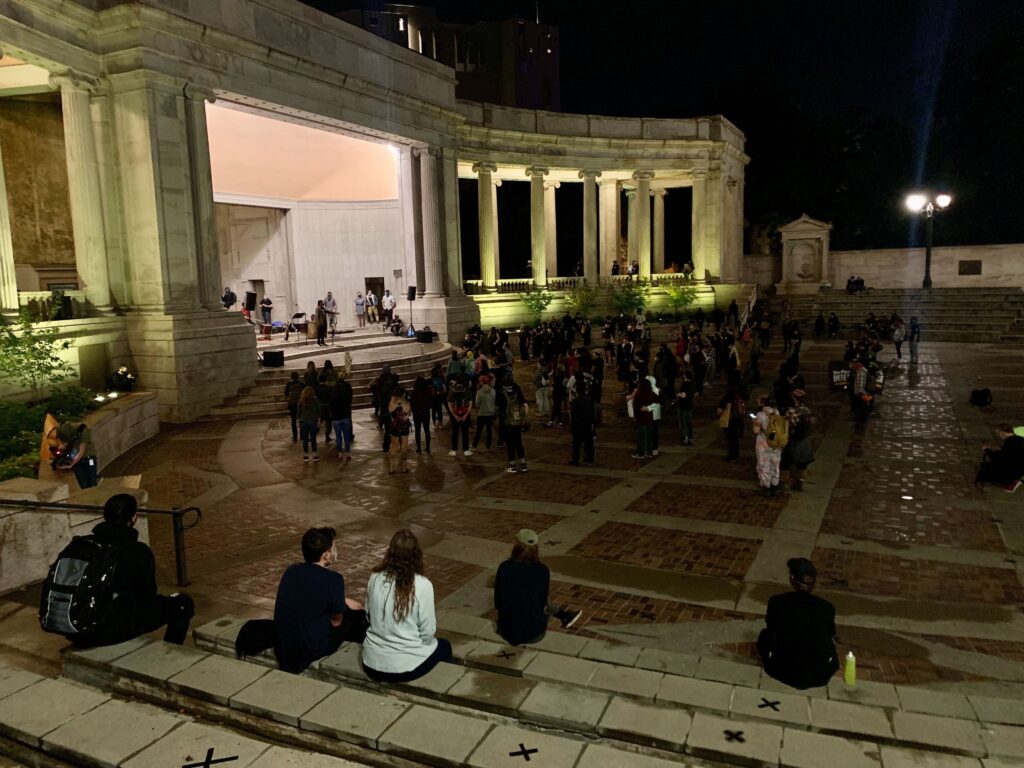
“The people that you see out here all follow different narratives, ranging from socialism, ranging from anarchists, Democrats, everywhere in between as well,” said Polo Phillips, who volunteers as a medic at protests and describes himself as a pacificist.
“You do see infighting all the time … Should people be destroying stuff or should they not?”
The opposition arrives
Social media has ensured that images of destruction in Denver and other cities are seen far and wide, especially in conservative circles.
That’s helped to draw an array of armed vigilante groups to demonstrations across the country. A researcher at Portland State University has identified nearly 600 examples. The confrontations have sometimes spilled over into violence, including the Kenosha shootings and the killing of a member of the right-wing Patriot Prayer group in Portland, not to mention countless brawls.
In Civic Center on that Friday night, fears of a confrontation were running high. An El Paso County resident named John Tiegen had issued a “call to action” to his 95,000 Instagram followers to counter “antifa and BLM rioters”.
He urged them to come to Denver with helmets and body armor, and he later used coded language to suggest they bring concealed-carry pistols while leaving their long guns, which are illegal to carry openly in Denver, at home.
Tiegen is known for his role as a security team member at the U.S. consulate in Benghazi during the 2012 attack. He’s prominently involved in the Trump campaign, receiving the honor of filing the president’s re-election paperwork in Colorado last November.
More recently, he's founded a group known as the United American Defense Force. “We’re not a militia, but we are going to be a defense force and stand up for what is ours,” Tiegen told an interviewer on YouTube.
On Facebook, Tiegen's UADF has warned that "(r)adical groups funded by our country’s enemies have organized plans of even more destruction and violence in the near future." The group advertises services such as tactical training, insurance and discounts on ammo for members.
Tiegen claims that the counter-demonstrations he has organized in Denver are not UADF operations, though he uses similar language to describe the goals of both. Tiegen did not respond to interview requests from CPR.
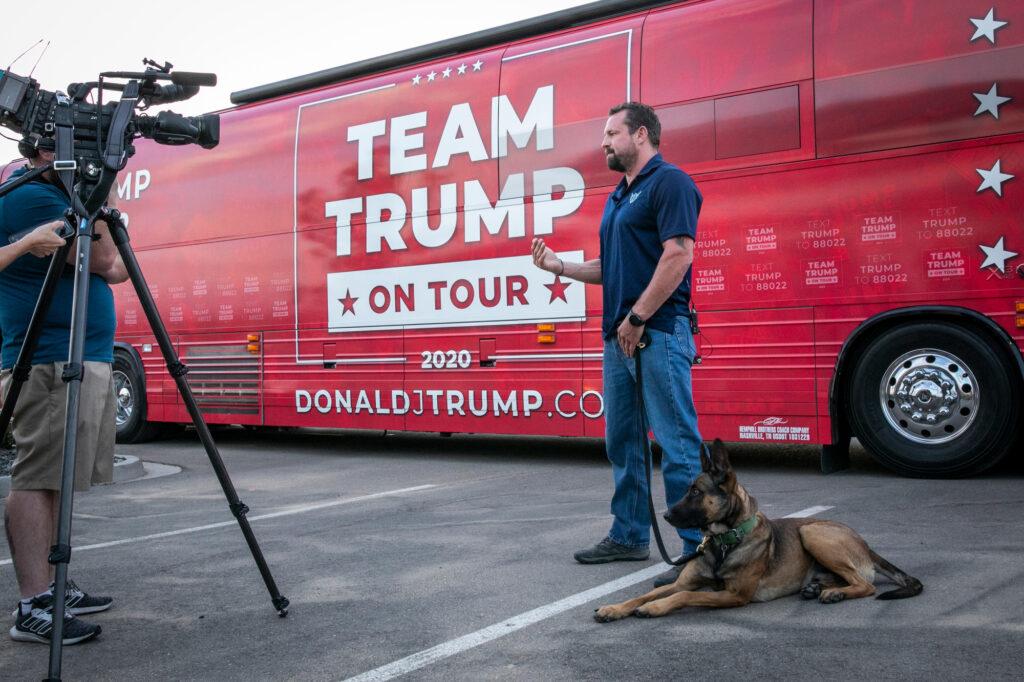
Tiegen's calls to action racked up thousands of likes and messages of approval, and word spread quickly among protesters too. Throughout the evening, demonstrators watched anxiously for signs of his group.
“We’re not looking for confrontation. We’re not looking for a fight,” said Eli Bazan, a burly man with a rainbow parasol who was helping with security for the main rally. He believed that the counter-protesters were specifically seeking out more-aggressive protesters.
“They are looking for people from a different event. … There are other elements that have mixed into our crowd and we’re doing our best to keep them out of harm’s way,” Bazan added.
Tiegen’s group was supposed to meet at the Cabela’s sporting goods store in Lone Tree before going downtown. Around 11 p.m., this reporter spotted a group of 50 or more men, many wearing camouflage and helmets. It was unclear whether they were armed.
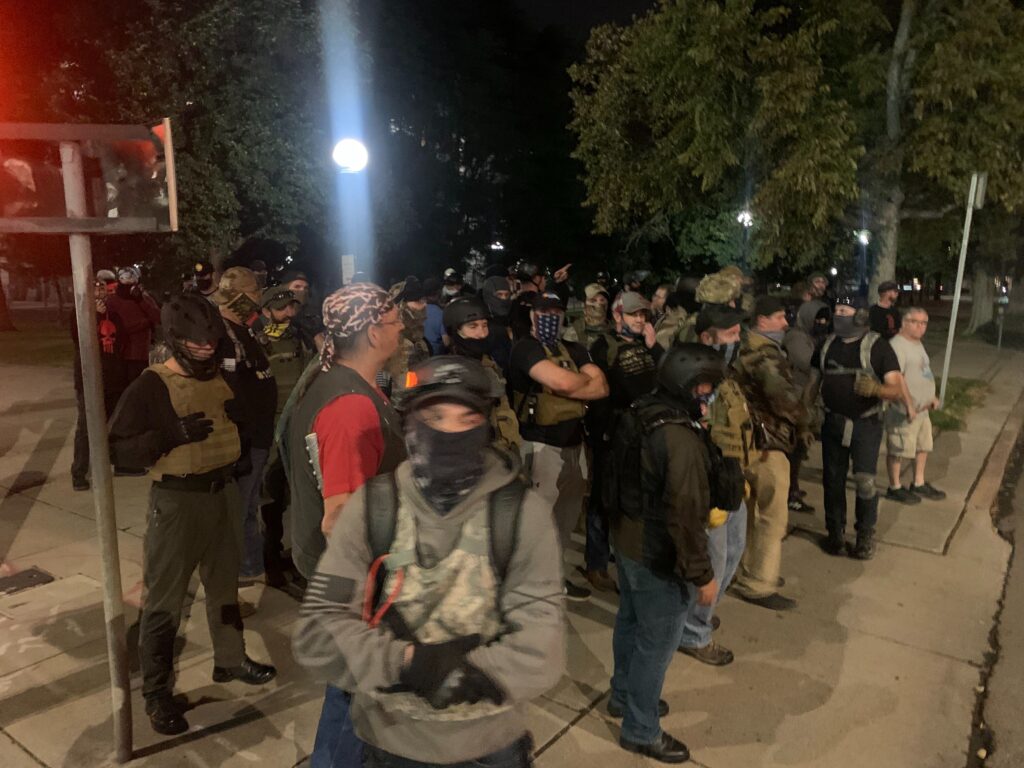
They were headed east from Civic Center toward Denver’s 6th police precinct, where officers had just fired pepper balls and tear gas to clear dozens of protesters away from a fence around the building.
The group wasn’t interested in explaining themselves, although one affirmed that they were with Tiegen. They claimed to be dressed up for "Halloween." When asked to identify themselves, men in the crowd responded by saying their names were Kyle -- an apparent reference to Rittenhouse, whom Tiegen has called an “American hero.”
“We’re all Kyle!” several men echoed. “You know why we’re here, don’t play dumb,” another said. The group stopped at crosswalks to regroup, then marched again with calls of “come on, Kyle.”

They ignored the taunts and questions of passersby. But they did speak with a stranger named David. A member of the group explained that he had joined because his family was afraid to go downtown with all the protests going on. They were prepared for violence but they didn’t want to see it, he said.
David, who is African American and declined to give his last name, was disturbed.
“I felt intimidated, and I felt I had to let them know I was ready for them, even without a weapon,” he said.
Minutes later, the counter-protest met the protest. The shouting reached a fever pitch as the two sides squared off in a parking lot.
Police quickly intervened, with a truck full of armored officers jumping between the opposing sides. They fired pepperballs to push the main protest group back down 14th Avenue in a cacophonous, eerie scene.
At the same time, a Denver police lieutenant was ordering counter demonstrators to disperse -- and thanking them.
“We really want you guys to just disengage and go back to your cars and call it a night, OK? Because we don’t want to have to take enforcement actions on you guys. We appreciate you coming here, and giving us support,” said Lt. Mike Cody.
Waiting for the next encounter
DPD would later say that the lieutenant's expression of gratitude was a de-escalation tactic, though some on the left saw it as proof that police favored the vigilante group.
“Our intelligence bureau is familiar with Mr. Tiegen and have had frequent conversations and contact with him. In our conversations with him, we do try to encourage him to stay at home,” DPD Division Chief Thomas said.
Tiegen has told the police he aims to “defend property and defend Americans,” Thomas said.
“But to me their activity is just as troublesome, because we don’t condone vigilantism, we don’t want those two groups to clash, and certainly they end up diverting our attention from this other group," Thomas said.
Tiegen’s group and other vigilantes have been on the streets about a half-dozen times in recent weeks, according to police, but the Aug. 28 incident was among their closest encounters with protesters.
It didn’t last long. An hour after that faceoff, the crowds had vanished. It was like nothing had happened downtown. The night had seen only one arrest.
A week later, about 75 late-night protesters again marched through the streets, which were thronged with thousands of partiers for Labor Day weekend. They shouted slogans for racial justice and promised to protect Black lives. They briefly spoke in Larimer Square and Union Station.
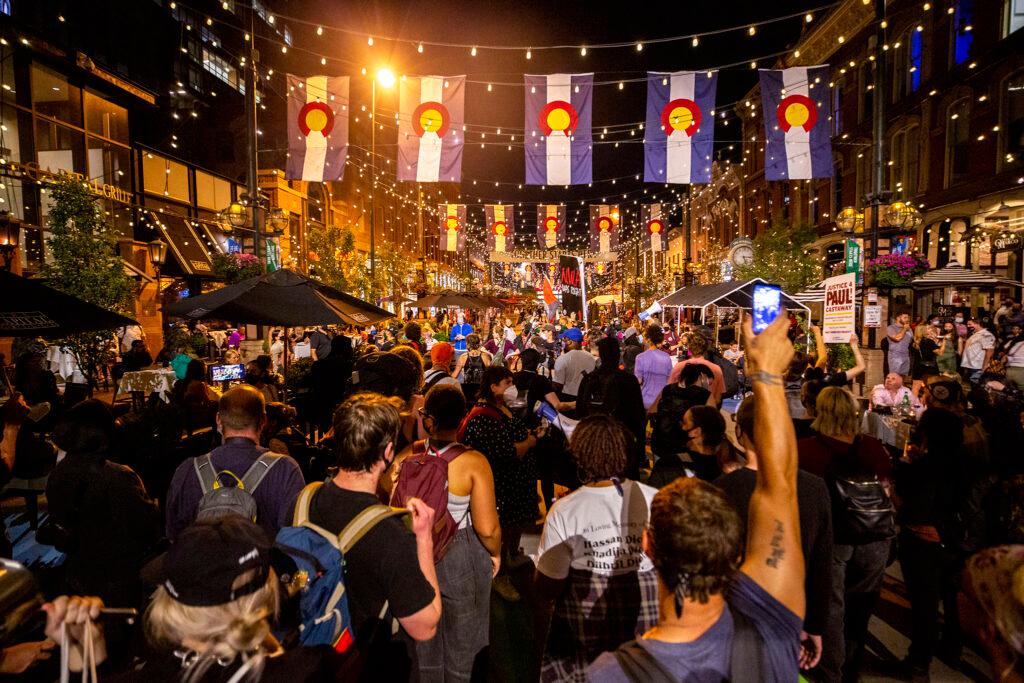
Teigen had again called on supporters to follow him downtown, but if any took him up on it, it appears they never encountered the protesters. Instead, the night concluded with a few tense shouting matches and a few fists thrown at the edges of the march.
Still, the bizarre war game on Denver’s streets appears set to continue. Protesters are on the streets this weekend after police fatally shot a man named Antonio Blackbear, whom police claim was armed with a handgun. There’s no sign of a counter-protest yet -- but on night after night, each side watches the other on social media, prepared to meet again.









